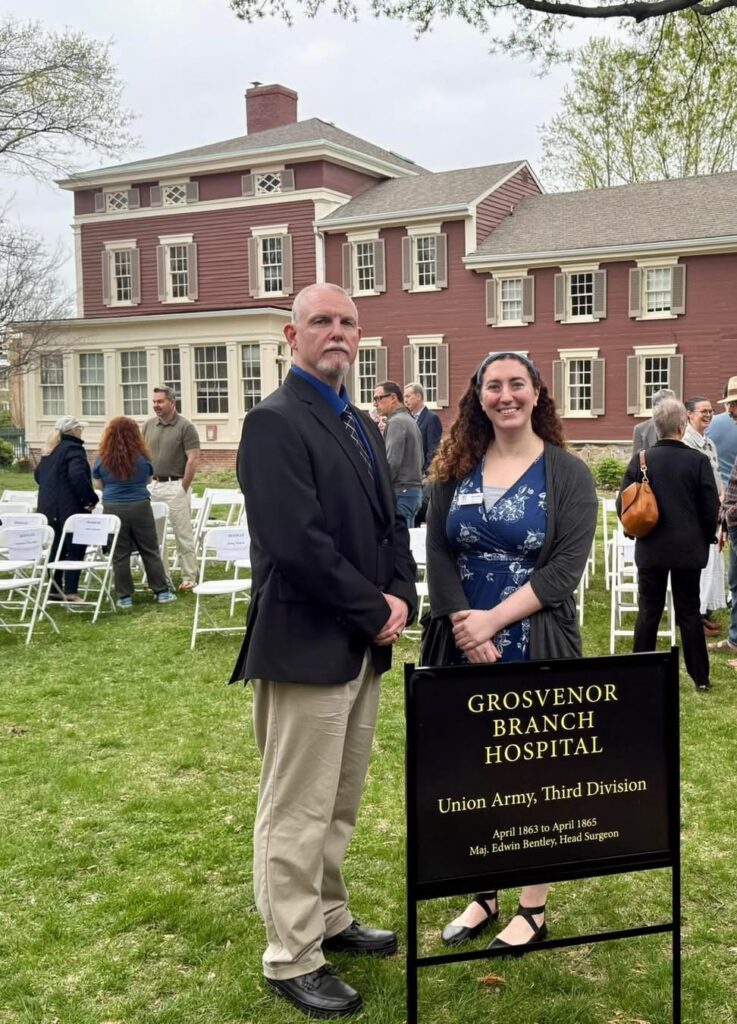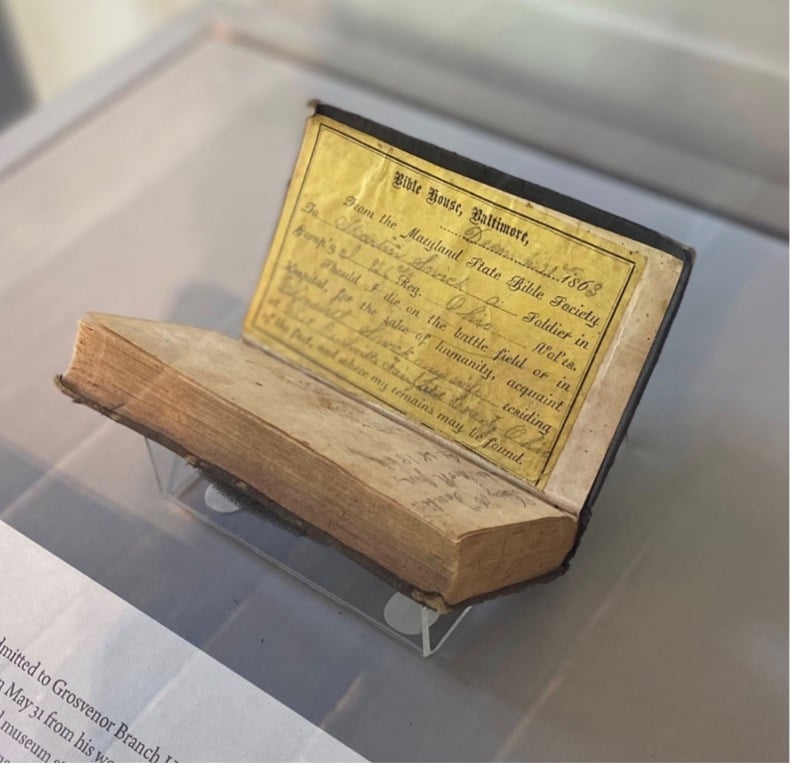Finding Martin Swick: Locating a Lost Civil War Ancestor
In early March 2023, I debuted the popular “Civil War Hospital Tour” at the Lee-Fendall House Museum in Alexandria, Virginia. This guided experience brought to life the house’s confiscation and use as a medical facility through its surgeons’ ledgers. We offered two tours that month and both sold out quicker than we ever thought. It turns out, many Alexandrians and travelers wanted to learn more about this obscure Union hospital. One of those visitors was Brent Reidenbach, the descendant of Martin Swick, a soldier who died at our Grosvenor Branch Hospital.
Brent’s journey to the doorstep of Lee-Fendall began in 1989. On a visit to the battle of Spotsylvania Courthouse with his father, they paused by a monument to the 126th Ohio and read aloud a name unfamiliar to Brent: his cousin Martin Swick. No one really knew how they were related to Swick, so he set out on a personal mission to uncover that connection. A proud Ohioan, Brent served his country with the Virginia National Guard and currently works for the Marine Corps at their Quantico recruitment office. He has a passion for military history and identifying Ohio-based soldiers in cemeteries around Virginia.

Brent provided the following information about Martin’s early life. Born in Fairfield County, Ohio around 1824, Martin married Elizabeth Harper of neighboring Perry County in 1850. Together, the couple had four children: Jerome (b.1850), James (b.1852), John (b.1860), and Emma (b.1862-63). According to the regimental descriptive book, Martin was a carpenter who stood 5’9 1/4 with a “fair complexion, blue eyes, and light hair.” I’ve had the pleasure of corresponding with Brent over the last two years about Martin.
Question: What inspired you to research more into Martin’s life and military service?
Answer: “I was immediately drawn to the name because my maternal grandmother’s maiden name was Swick, but I knew next to nothing about the Swick family – let alone anything about Martin. When I started asking questions, I kept getting shoulder shrugs and ‘I don’t know.’ It wasn’t until I returned from Germany, and was stationed in the Alexandria-area, when I decided to go ‘all in’ researching Martin and the 126th Ohio. Since that time, I have found out that Martin and my 3x great-grandfather, John Wesley Swick, are first cousins. This makes Martin my first cousin, 6x removed. It was also around this time that I came into possession of Martin’s bible. It was found in a used bookstore out in The Valley, given to a gentlemen as a birthday present. This man and his wife made a promise to return the bible to Martin’s family, passing it onto me.”
Question: What was Martin’s service prior to his unfortunate death at the hospital?
Answer: “Martin enlisted on August 28, 1862 in Fairfield County, Ohio and was mustered into Company I, 126th Ohio Volunteer Infantry on October 11 at Camp Steubenville. He participated in the response to the Jones-Imboden Raid and the battle of Martinsburg, where he was captured. Martin spent about two weeks in Richmond, most likely at Belle Isle, before his parole on July 8, 1863. He lingered for 90 days at Camp Parole in Annapolis, Maryland before returning to his unit in October 1863. Martin went on to participate in the Bristow Station Campaign, the battle of Kelly’s Ford, and witness the Mine Run Campaign. Martin was promoted to corporal in April 1863, but later reduced to private rank at his own request in April 1864. In May 1864, Martin fought in the battles of the Wilderness and Spotsylvania Court House, where he was mortally wounded.”

Brent believes that his ancestor was brought by an Alexandria-based ship from nearby Aquia Harbor. Many soldiers were transported to this hospital center by way of its port or rail network. The summer before Brent contacted the Lee-Fendall House, I had transcribed Martin’s name from the original medical ledgers into our mass database. We knew a man named Martin Swick was admitted to Grosvenor Branch on May 25, 1864 for a “gunshot wound in the left shoulder.” His compiled service record, provided by Brent, details the exact location of that minie ball and the treatments offered to Martin: dressings, sceptics, and stimulants. Despite all that was done on his behalf, Martin died from his injuries on May 31. He is buried in Section A of Alexandria National Cemetery, along with 55 other soldiers from Grosvenor Branch Hospital.

Question: So, what is the next step? What do you still want to know about Martin?
Answer: “The next step has always been tracking down descendants of Martin and Elizabeth’s children, follow their movements after Martin’s death, and to see what information has been shared through the years. I’m very interested in seeing if Martin had written home and if any of those letters survived. I’m also interested to see if any diaries exist. Martin allegedly had at least one diary (possibly more) with him at the time of his death, based on the inventory of effects conducted by the staff at Grosvenor Branch. I’m also in the process of expanding my research to the 126th Ohio as a whole, following them all the way from their organization at Camp Steubenville to the surrender at Appomattox.”
In March 2024, Lee-Fendall showcased an exhibit that featured Martin Swick’s story. “From Battlefield to Bedside: Alexandria’s Civil War Medical History” displayed Martin’s bible, the one returned to Brent by the generous couple. Aside from the medical ledgers housed at the National Archives, this book is the only surviving artifact from Grosvenor Branch Hospital.
“While I have some places yet to visit, standing in the places where he stood and seeing the things he saw – especially where Martin died – allows me to be more appreciative of his service and sacrifice. Standing in the building where Martin’s life and service came to end culminates 20+ years of research.”
Biography
Madeline Feierstein is an Alexandria, VA historian specializing in psychiatric institutions, hospitals, and prisons. A native of Washington, D.C., her work has been showcased across the Capital Region. Madeline leads efforts to document the sick, injured, and imprisoned soldiers that passed through Civil War Alexandria. Additionally, she supports the National Museum of Civil War Medicine and interprets the burials in Alexandria’s historically rich cemeteries with Gravestone Stories. Madeline holds a Bachelor of Science in Criminology from George Mason University and a Master’s in American History from Southern New Hampshire University. Explore her research at www.madelinefeierstein.com.
Another touching story about the real people who still are affected by our Civil War. Thank you.
Madelaine’s work always provides fascinating insights, and I have a question for her, though forgive me, it is not related to this piece. When we read Civil War history we often encounter mention of men fainting and even dying due to sunstroke, either on the march or in battle. Were any official records kept by either side on sunstroke cases? I’m working on a piece on the Battle of Gaines’ Mill, June 27, 1862, during which both armies had strenuous marches and then fought viciously for eight hours in 90-100-degree heat in the humidity of Virginia. Thus, hundreds must have been felled by sunstroke during the battle, and this prompts my query about official records on this affliction.
Thank you so much! And yes, I’ve seen “sunstroke” as a cause of admission to hospital and cause of death in Civil War records. I have glanced as these within the medical ledgers of Alexandria’s hospitals, though sometimes it can categorized as general “fatigue.” Hope this helps 🙂